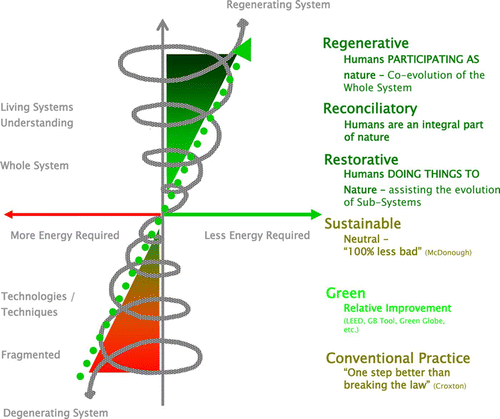If you have been paying attention recently, it’s pretty hard to miss the fact that we are in a climate crisis. The fact that we, as Californians, have a “wildfire season” and don’t know which mornings we are going to wake up to smoke in our lungs should say enough about the current condition of our environment. But in this era of fake news and fake science, what should the future of sustainability look like? Some think that it’s all about that big buzzword: sustainability. Others think that it’s a bit more complicated than that.
When we discuss the environment and ways we can “go green”,one word seems to pop up everywhere: sustainability, our ability to sustain and coexist with the other life on this planet. We think of sustainability as this giant goal we should all strive towards, the ultimate solution to the climate crisis. However, is this enough? Is it enough to merely sustain? Some might say no. Some might say it is our job, not to just sustain, but to regenerate. But what is regeneration? And what implications does it have for the future of our global environment?
Daniel Christian Wahl, author of the article Why Sustainability is no Longer Enough, Yet Still Very Important on the Road to Regeneration argues that sustainability simple means “not adding any more damage,” and argues that, “after 250 years of industrialization and 5,000 years of deforestation and agriculture, that is no longer enough.” In his proposed solution that addresses his case that sustainability is no longer enough, we must focus instead on the concept of regeneration, which Wahl describes as a process involving the practice of committing to “widespread ecosystems restoration,” and allowing humanity to “reconcile nature and culture and change the guiding cultural narrative.”
According to Wahl, sustainability from the point where we are now cannot be our main goal. The main goal is to avoid future climate crises and ensure an improvement in planetary health. To do this, we must rebuild and develop a new culture that places long-term coexistence between nature and humanity at the helm of all new development. Keeping in mind sustainable practices, which are a key stepping stone in this process, Wahl argues that humanity, if it succeeds in reconstructing our planet and creating, “conditions conducive to life”, will “thrive and flourish in the 22nd century and beyond.”
So, what are some examples of regenerative practices? Regeneration involves anything that aims to undo the damages to our ecosystem humanity has been inflicting since the mid eighteenth century with the beginning of the Industrial Revolution and inviting in a new dawn of growth. Regenerative practices entail not merely bringing an end to deforestation, but ushering in the beginning of RE-forestation.
From that point, the practice of regeneration entails that we, as humans, must then place ourselves, not as outsiders looking into that forest and watching it grow, but as an integral and participatory part of that ecosystem. This concept of regeneration involves creating a new society that learns that when nature thrives, so do we. However, how realistic is this? Is creating a “new society” that sees themselves and everything they design as a facet within the larger scope of the global ecosystem in the few years we have to prevent against irreversible environmental damage really feasible?
Evander Li, president of the San Mateo High School Green Team, says he believes the most effective way to bring an end to climate crisis is not through this new concept. He proposes bringing “all of the nations together to agree to do well” in terms of climate accountability and make those nations understand that “there are sacrifices that need to be made.”
Maybe diplomatic relations are the best solution. Maybe there is a reason that, when asked about regeneration in the context of this current climate crisis, Kelsi Kobara, a recent graduate of Sonoma State University, said she has “never heard of it.” Maybe regeneration is just the latest of what seems like a never-ending cycle of grasping at straws when it comes to environmentalism.
This concept is, as most proposed solutions to the state of our current global environment are, incredibly convoluted and complex. From what I could gather, at its core, regeneration is simply sustainability that takes into consideration undoing past damages and rebuilding from a point where nature and humanity grow together in a symbiotic relationship rather than a parasitic one. Is there really even a best solution to climate change?
Maybe, instead of arguing from whose corner we should attack this issue, we all attack climate change in our own way, from our own corner, in whichever way we know how. We don’t need to give it some fancy name like regeneration or sustainability. We can just protect what little parts of the planet we can and assist as many people as possible to do the same.

